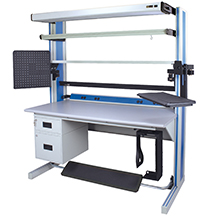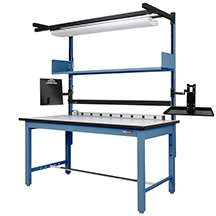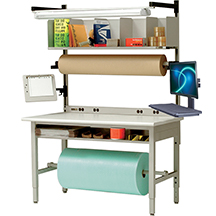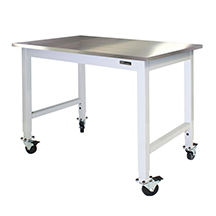Integrating Workstations, Conveyor Systems
By Joy M. Ebben, Ph.D, CPE
Human Factors and Ergonomic Specialist, IAC, a Division of Treston, Brea, Calif.
Parrallel layouts... can reduce awkward postures and improve line of sight in both directions...
In manual assembly operations, using workstations with conveyors creates a common ergonomic problem. Typically, operators are forced into awkward, nonneutral working postures while the conveyors generate contact force on arms, wrists or legs.
Ergonomic workstation design has improved integration with conveyors for seated operations. Achieving proper working height for standing operations is costly when conveyors are involved.
Why Use Conveyors?
The conveyor, not the worker, moves the product. This reduces material handling time and human energy expended.
Sometimes it is better for one person to complete all the assembly tasks. Not only does this lead to job enlargement, and possibly increased job satisfaction, it could reduce risk of musculoskeletal disorders.
Besides creating ergonomic problems for the workstation configuration, conveyor systems are usually in fixed configurations. A straight-line conveyor cannot be easily reconfigured into a U-shaped conveyor. Confirm that an integrated workstation/ conveyor system is correct for your operation.
The primary conveyor application for moving product between people is in-line assembly. For example, each person performs a small number of assembly steps relatively quickly and several people complete all steps.
Layout Considerations
Typical workstations/conveyor layouts position the station either perpendicular or parallel to the conveyor.
A perpendicular orientation usually forces the user into awkward postures while moving items on ad off the conveyor. The extent of this problem depends on the size of the workstation, the operator’s location, and the size and shape of the item being moved. Another shortcoming of a perpendicular layout is that workers can’t easily see product and people in both directions.
Parallel layouts, however, reduce awkward postures and improve line of sight in both directions if they are designed properly. In either configuration, a good design for seated operations provides the following:
- Minimal reach distances to the conveyor—depending on reach frequency, item weight, item size and conveyor width. This requires a narrow worksurface but one large enough to store tools and perform tasks. Distances include vertical as well as horizontal reach if the conveyor is located above the worksurface.
- Sufficient clearance for knees, legs and toes underneath the worksurface and conveyor. Depending on the design, this may require a thinner conveyor system.
- Accommodation for different working height requirements of different employees through the use of adjustable chairs and footrests. The appropriate adjustment range for the chair and footrest is calculated based on working height and employee stature. Position the worksurface for the tallest employee; then adjust for shorter people.
- Assistance with moving heavy items off and onto the conveyor. Ball-transfer systems can be useful for this.
- Minimal contact stress between body parts, the front edges of worksurfaces, and with the metal components of the conveyor system.
Considering assembly workstations with conveyor systems? Address ergonomic issues to avoid exposing employees to musculoskeletal risks. A professional ergonomist can help you design a successful implementation.
 Buy Online Now!
Buy Online Now!
 Buy Online Now!
Buy Online Now!











